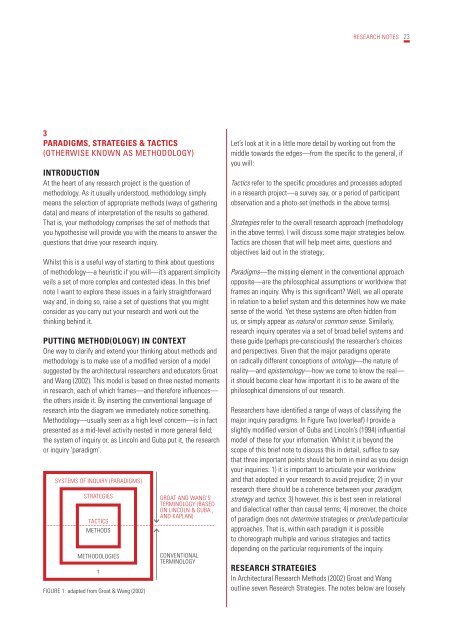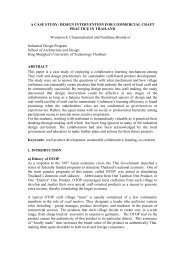soa+d research manual - School of Architecture and Design, KMUTT
soa+d research manual - School of Architecture and Design, KMUTT
soa+d research manual - School of Architecture and Design, KMUTT
Create successful ePaper yourself
Turn your PDF publications into a flip-book with our unique Google optimized e-Paper software.
3<br />
PARADIGMS, STRATEGIES & TACTICS<br />
(OTHERWISE KNOWN AS METHODOLOGY)<br />
INTRODUCTION<br />
At the heart <strong>of</strong> any <strong>research</strong> project is the question <strong>of</strong><br />
methodology. As it usually understood, methodology simply<br />
means the selection <strong>of</strong> appropriate methods (ways <strong>of</strong> gathering<br />
data) <strong>and</strong> means <strong>of</strong> interpretation <strong>of</strong> the results so gathered.<br />
That is, your methodology comprises the set <strong>of</strong> methods that<br />
you hypothesise will provide you with the means to answer the<br />
questions that drive your <strong>research</strong> inquiry.<br />
Whilst this is a useful way <strong>of</strong> starting to think about questions<br />
<strong>of</strong> methodology—a heuristic if you will—it’s apparent simplicity<br />
veils a set <strong>of</strong> more complex <strong>and</strong> contested ideas. in this brief<br />
note i want to explore these issues in a fairly straightforward<br />
way <strong>and</strong>, in doing so, raise a set <strong>of</strong> questions that you might<br />
consider as you carry out your <strong>research</strong> <strong>and</strong> work out the<br />
thinking behind it.<br />
PUTTING METHOD(OLOGY) IN CONTExT<br />
One way to clarify <strong>and</strong> extend your thinking about methods <strong>and</strong><br />
methodology is to make use <strong>of</strong> a modified version <strong>of</strong> a model<br />
suggested by the architectural <strong>research</strong>ers <strong>and</strong> educators groat<br />
<strong>and</strong> Wang (2002). This model is based on three nested moments<br />
in <strong>research</strong>, each <strong>of</strong> which frames—<strong>and</strong> therefore influences—<br />
the others inside it. by inserting the conventional language <strong>of</strong><br />
<strong>research</strong> into the diagram we immediately notice something.<br />
methodology—usually seen as a high level concern—is in fact<br />
presented as a mid-level activity nested in more general field;<br />
the system <strong>of</strong> inquiry or, as lincoln <strong>and</strong> guba put it, the <strong>research</strong><br />
or inquiry ‘paradigm’.<br />
sysTEms Of iNQuiRy (PARADigms)<br />
sTRATEgiEs gROAT AND WANg’s<br />
TERmiNOlOgy (bAsED<br />
ON liNcOlN & gubA ,<br />
AND KAPlAN)<br />
TAcTics<br />
mEThODs<br />
mEThODOlOgiEs<br />
figuRE 1: adapted from groat & Wang (2002)<br />
?<br />
cONVENTiONAl<br />
TERmiNOlOgy<br />
REsEARch NOTEs<br />
let’s look at it in a little more detail by working out from the<br />
middle towards the edges—from the specific to the general, if<br />
you will:<br />
Tactics refer to the specific procedures <strong>and</strong> processes adopted<br />
in a <strong>research</strong> project—a survey say, or a period <strong>of</strong> participant<br />
observation <strong>and</strong> a photo-set (methods in the above terms).<br />
Strategies refer to the overall <strong>research</strong> approach (methodology<br />
in the above terms). i will discuss some major strategies below.<br />
Tactics are chosen that will help meet aims, questions <strong>and</strong><br />
objectives laid out in the strategy;<br />
Paradigms—the missing element in the conventional approach<br />
opposite—are the philosophical assumptions or worldview that<br />
frames an inquiry. Why is this significant? Well, we all operate<br />
in relation to a belief system <strong>and</strong> this determines how we make<br />
sense <strong>of</strong> the world. yet these systems are <strong>of</strong>ten hidden from<br />
us, or simply appear as natural or common sense. similarly,<br />
<strong>research</strong> inquiry operates via a set <strong>of</strong> broad belief systems <strong>and</strong><br />
these guide (perhaps pre-consciously) the <strong>research</strong>er’s choices<br />
<strong>and</strong> perspectives. given that the major paradigms operate<br />
on radically different conceptions <strong>of</strong> ontology—the nature <strong>of</strong><br />
reality—<strong>and</strong> epistemology—how we come to know the real—<br />
it should become clear how important it is to be aware <strong>of</strong> the<br />
philosophical dimensions <strong>of</strong> our <strong>research</strong>.<br />
Researchers have identified a range <strong>of</strong> ways <strong>of</strong> classifying the<br />
major inquiry paradigms. in figure Two (overleaf) i provide a<br />
slightly modified version <strong>of</strong> guba <strong>and</strong> lincoln’s (1994) influential<br />
model <strong>of</strong> these for your information. Whilst it is beyond the<br />
scope <strong>of</strong> this brief note to discuss this in detail, suffice to say<br />
that three important points should be born in mind as you design<br />
your inquiries: 1) it is important to articulate your worldview<br />
<strong>and</strong> that adopted in your <strong>research</strong> to avoid prejudice; 2) in your<br />
<strong>research</strong> there should be a coherence between your paradigm,<br />
strategy <strong>and</strong> tactics; 3) however, this is best seen in relational<br />
<strong>and</strong> dialectical rather than causal terms; 4) moreover, the choice<br />
<strong>of</strong> paradigm does not determine strategies or preclude particular<br />
approaches. That is, within each paradigm it is possible<br />
to choreograph multiple <strong>and</strong> various strategies <strong>and</strong> tactics<br />
depending on the particular requirements <strong>of</strong> the inquiry.<br />
RESEARCH STRATEGIES<br />
in Architectural Research methods (2002) groat <strong>and</strong> Wang<br />
outline seven Research strategies. The notes below are loosely<br />
23



